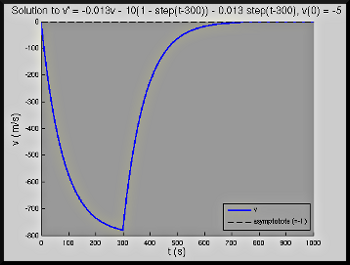Abstract
We consider a simple model for a rocket falling to Earth that lands safely by firing its rocket to slow its descent to a reasonable speed for landing. With not unreasonable assumptions, this gives the model \[ v' = -c v - \begin{cases} g, & \quad t < t_0\\ a, & \quad t \ge t_0, \end{cases} \] where \(c = \frac1{80}\), \(g = 10\), and \(a = \frac1{80}\). This is a simple problem with piecewise forcing that may be written with step functions and the resulting equation solved with Laplace transforms.
Use Cases
Lecture: The modeling equation may be written down with little explanation. Rewriting the forcing in terms of step functions and solving with Laplace transforms are useful exercises. The demonstration here plots the solution.
Outside of Lecture: Rewrite the forcing term in this equation in terms of step functions and solve the resulting equation with Laplace transforms. Verify that the solution you obtain produces the same graph as the demonstration.
Model Description

We model the rocket as a freely falling object with linear air resistance, as suggested in the figure to the right. Initially the only forces on the rocket are gravity \(F_g\) and air resistance \(F_a\); after the rocket starts firing, we have the added force \(F_r\). This gives the simple model for the velocity \(v\) of the rocket, \[\begin{align} m v' &= F_a + F_g + F_r \\ &= -k v - m g + F_r. \end{align}\] If we assume that the force of the rocket provides a constant acceleration we may combine it with the gravitational acceleration to get \[ v' = -c v - \begin{cases} g, & \quad t < t_0\\ a, & \quad t\ge t_0. \end{cases}\] (Where we have taken \(c = k/m\) and assumed that the acceleration provided by the rocket is less than gravity, so that \(a>0\) and the rocket will continue to fall.)
Rounding the acceleration due to gravity, we have \(g \approx 10 \mbox{ m/s}^2\). A rough calculation based on the weight of the space shuttle orbiter (250,000 lb [1]) using a drag coefficient of 1 (that for a prism is 1.14 [2]) and taking the density of air to be 1.3 kg/m\({}^3\) [4, 5] gives a terminal velocity of about 770 m/s\({}^2\) [3], which is consistent with the value suggested by [6]. Assuming that this could be the result of a linear drag (the actual drag is more likely quadratic [3]), we obtain \(c\approx 1/77\). We will take \(c = 1/80\). Then if we take a terminal velocity with the rocket firing to be \(-1\) m/s, we have \(a = 1/80\) as well. Thus we have \[ v' = -\frac1{80} v - \begin{cases} 10, & \quad t < t_0\\ 1/80, & \quad t\ge t_0. \end{cases}\]
Matlab Demos
Our demos:
- Rocket_Lander.m:
A very simple demo that plots the solution to the differential
equation. The parameters \(c\), \(g\), \(a\) and \(t_0\) are
specified at the beginning of the file, as is the initial velocity
\(v_0\).
[show
figure]

Looking at the Model
Some questions that may be worth considering:
- How is the solution we find here related to our solution techniques for linear constant coefficient problems?
- Can you solve the problem using those techniques to find the solution here?
References
- Benson, T.J., ed. (date unavail.) Rocket Weight. NASA. Retrieved on: 14 May 2013.
- Benson, T.J., ed. (date unavail.) Shape Effects on Drag. NASA. Retrieved on: 14 May 2013.
- Benson, T.J., ed. (date unavail.) The Drag Equation. NASA. Retrieved on: 14 May 2013.
- Wikipedia (2013). Density of Air. Retrieved on: 14 May 2013.
- Helmenstine, A.M. (2013). What Is the Density of Air at STP?. Retrieved on: 14 May 2013.
- Lunar and Planetary Institute (2012). About Space Capsules. Retrieved on: 14 May 2013.
